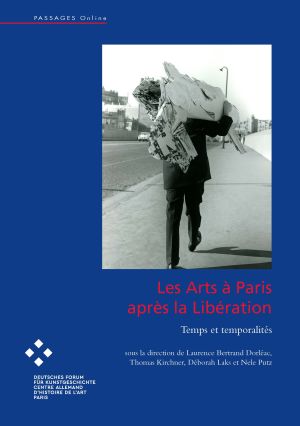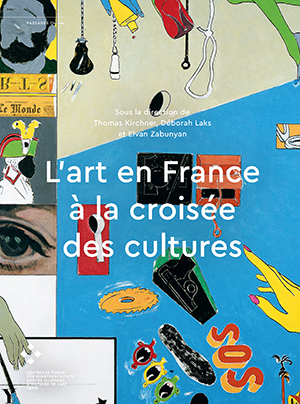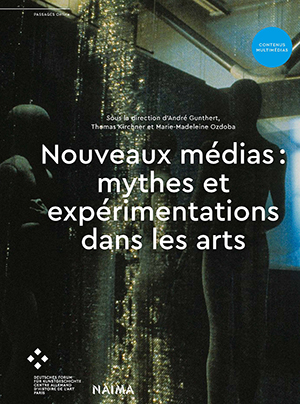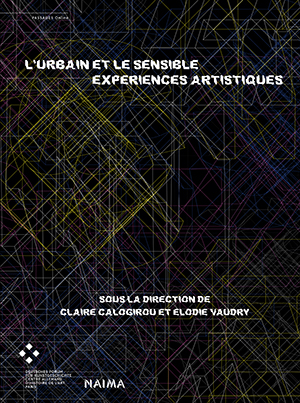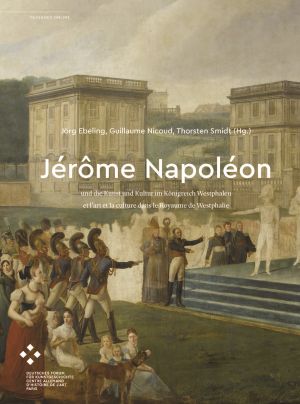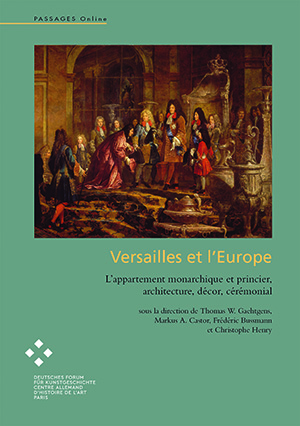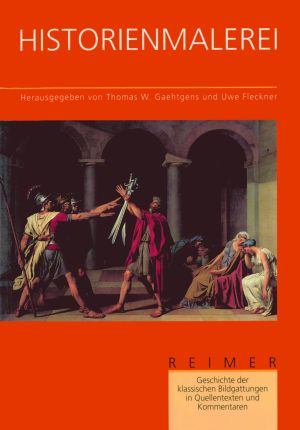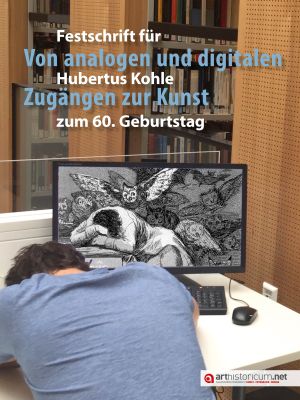Kirchner, Thomas
Les Arts à Paris après la Libération: Temps et Temporalités
The volume sheds new light on the Parisian art world after the Second World War, its protagonists, inter(national) dimensions and aesthetic challenges. It assembles a selection of contributions of the annual congress 2014/15 held at the German Center for Art History Paris as well as further results of research undertaken during that same year. Besides questions of historiography the publication focuses on case studies in which renowned artists like Giacometti, Picasso and Brassaï are analized. Furthermore, new protagonists, institutions and media are introduced and innovative perspectives developed. The volume thus makes a valuable contribution to the reevaluation of art of the postwar period.
L’art en France à la croisée des cultures
This book collects the reflections and discussions generated at the DFK Paris in the context of the annual theme 2016/17 “Art in France in a Transcultural Context”. The intense exchange between this year’s researchers expanded beyond their individual projects and questioned Eurocentrism, analyzed specific forms of hegemony and demonstrated the consequences of colonial history. By exploring different case studies in African, American, Asian, European, and Oceanian contexts, it could be shown how artistic and intellectual creation and engagement inscribe themselves into the mobilities of globalism. Reflecting on the interdependencies between the repositionings described and art history, the need to acknowledge in art historical analysis the cross-paths, the disorientations, the fragmentary, and the uprooted – here and now, here and elsewhere – becomes clear.
Cet ouvrage rassemble la somme des réflexions et discussions menée au DFK Paris dans le cadre du sujet annuel de 2016/17 « Les arts en France à la croisée des cultures ». Avec leur échange intensif, les chercheurs ont pu renforcer le questionnement de l’eurocentrisme ainsi que démontrer et analyser les différentes formes de l’hégémonie et les conséquences des histoires coloniales. En examinant des différentes études de cas dans les contextes africains, américains, asiatiques, européens et océaniens, il devient évident que la création et l’engagement artistiques et intellectuels appartiennent aux mobilités de la mondialité. Mettant en avant les interdépendances entre les repositionnements décrits et l'histoire de l'art, on comprend la nécessité de reconnaître dans l'analyse en histoire de l'art les chemins de traverse, les désorientations, le fragmentaire et les déracinements - ici et maintenant, ici et ailleurs.
L'art de l’Ancien Régime: Sortir du rang !
The history of art in the Ancien Régime has mainly focused on the major players, the "Fine Arts", the best documented institutions, Paris, other capitals and the courts. This book invites us to go beyond this "top-down" history, by bringing together the analytical frameworks of art history with approaches from social history, anthropology, material and visual culture, the history of science and technology, the sociology of networks, and gender studies. Revisiting historiographical frameworks, challenging academic canons and norms, questioning the margins, decentering the gaze, in a word "stepping out of line" - this is the methodological and thematic thread. Deployed around a wide range of media, genres, and objects, the eighteen contributions gathered in this volume seek to grasp the visual and material culture of the period in all its richness and complexity.
L’histoire de l’art de l’Ancien Régime s’est principalement focalisée sur les grands acteurs, les « beaux-arts », les institutions les mieux documentées, Paris, d’autres capitales et les cours. Le présent ouvrage invite à dépasser cette histoire « par le haut », en faisant dialoguer les cadres analytiques de l’histoire de l’art avec les approches de l’histoire sociale, de l’anthropologie, de la culture matérielle et visuelle, de l’histoire des sciences et des techniques, de la sociologie des réseaux et des études de genre. Revisiter les cadres historiographiques, défier les canons et les normes académiques, interroger les marges, décentrer le regard, en un mot « sortir du rang » – tel en est le fil conducteur méthodologique et thématique. Déployées autour d’un large éventail de médias, de genres, d’objets, les dix-huit contributions réunies dans ce volume s’attachent à saisir la culture visuelle et matérielle de l’époque dans sa richesse et sa complexité.
Nouveaux médias: mythes et expérimentations dans les arts
With the editorial participation of Sara Alonso Gómez, François Aubart, Juliette Bessette, Marie-Laure Delaporte, Claus Gunti, Caroline Marié, Julie Martin and Marie Vicet.
https://newmedia.dfk-paris.org/
Research in art history on the relations between the arts and new media interrogates not only the wealth of experimental forms but also issues of resistance to visual hegemony – from the debut of cinema to virtual reality devices, and by way of video art and cybernetic art.
This publication distances itself from the mythology of new media as a symbol of modernity, seeking to grasp these issues through artistic practices. Far from the technological determinism that has contributed to structuring the field, it approaches media and techniques as tools for investigating art and culture. Twenty-four scholarly and artistic contributions offer an extensive mapping of the most recent research, reconfiguring our understanding of museum practices, of the role of technology, and of the artistic object and the experience of audiences.
Related research data on arthistoricum.net@heiDATA
L’urbain et le sensible: Expériences artistiques
This book is the result of a fruitful exchange between scholarship holders and guests of the DFK Paris as part of the 2021-2022 annual theme ‘Street Art’. The authors gathered here with their contributions share an interest in aesthetic practices in urban space and its use. Their aim is to raise awareness of the ways in which the city can be appropriated through a gaze, a path or through writing, be it in a political, visual artistic, democratic, challenging, playful or multi-sensory form. One of the peculiarities of this relationship is the shared, pronounced sense of questions of emotionalisation and taste judgement. As a fundamental factor, the street lends its aesthetic dimension to such behaviour.
Cet ouvrage rassemble la somme des fructueux échanges menés par les boursiers et les invités du DFK Paris dans le cadre du sujet annuel 2021-2022 « Street Art ». Tous partagent un intérêt pour les pratiques et les usages sensibles de l’espace urbain – autrement dit, les manières de s’emparer de la ville par un regard, un parcours, des écrits, que ce soit par une forme politique, esthétique, démocratique, revendicative, ludique ou multisensorielle. L’une des particularités de ces pratiques est un sens aigu des émotions et des goûts partagés avec d’autres. Composante fondamentale, la rue leur confère une dimension esthétique.
Jérôme Napoléon - und die Kunst und Kultur im Königreich Westphalen / et l’art et la culture dans le Royaume de Westphalie: Kolloquiumsakten und Archive / Colloque et recueil d’archives
Malgré ses six années d’existence, le royaume de Westphalie dirigé par le plus jeune des Napoléonides Jérôme Bonaparte (1784-1860), surnommé le « König Lustik », apparaît comme un exemple paradigmatique des transferts artistiques et culturels entre la France et l’Allemagne. Les textes réunis dans le présent volume explorent les modèles et influences françaises de même que les tendances locales à l’assimilation ou à la modification de la vie culturelle multiforme de la capitale westphalienne et de ses provinces. Étayée par une sélection d'archives conservée en Allemagne et en France traitant de la thématique de « l'art et de la culture sous le roi Jérôme Napoléon », cette étude aspire à fournir une base essentielle pour l'exploration précise de la relation entre centre et périphérie dans l'Europe napoléonienne.
Versailles et l'Europe: L’appartement monarchique et princier, architecture, décor, cérémonial
The volume presented here examines the influence of one of the most splendidly representative achievements of the early modern period upon the European courts of the 17th and 18th centuries. The Palace of Versailles was a showroom which made French luxury items known, and desired, far beyond the borders of France, drawing the attention of all regents of the time, and although numerous forms and ideas were borrowed by the artists and craftsmen who settled in the various European courts, the persistence of local traditions should not be under-estimated.
Starting with an analysis of the form and function of the Versailles apartments, the French model is considered for its influence upon the concept of the apartment at other European courts. The contributions to this volume analyse the interplay between architecture, décor and ceremony and the particular importance of the apartments for the representation of the court. The arrangement of the rooms is shown to be a complex referral system that decided the presentation of power and accessibility to the regent. The rationale of the interior design is only revealed through an interdisciplinary examination which also takes into consideration the social and political/historical conditions. Already existing traditions of the European houses were transferred and adapted, and therefore newly configured, as part of this process.
The first part of the volume concentrates on the model of the apartment developed in France and attempts an understanding of the complex development in Versailles up to 1701, within which the Chambre de Parade became the centrepiece of the Palace. The second part contains case studies of residences in the German-speaking countries and examines the complex exchange and variety of the heterogeneous solutions. The study concludes with contributions about various important European courts in England, Holland, Sweden, Poland, Spain and Italy.
__________
Le présent volume trouve son origine dans un projet aussi légitime qu’attendu : étudier l’influence sur les autres cours européennes de celle qui fut la plus brillante d’entre elles. Le château de Versailles, « showroom » étincelant contribuant à l’exportation des biens luxueux de la culture française hors des frontières, était au centre de tous les regards européens. Si des artistes et artisans français partis s’installer dans les pays germanophones empruntèrent nombre de ses formes et idées, sous-estimer la persistance des traditions locales serait néanmoins une erreur.
Analysant la forme et la fonction de l’appartement royal du château de Versailles, cet ouvrage examine sa portée en tant que modèle de référence pour les conceptions ultérieures d’appartements princiers en Europe. Le livre rassemble des travaux relatifs à l’architecture, à la décoration et au cérémonial des appartements des résidences royales et princières en Europe. L’accent est mis sur leur rôle spécifique dans le cérémonial de la cour. Dans cette perspective, l’effet conjoint de la disposition spatiale, de l’architecture et de la décoration apparaît comme un facteur complexe, influençant de manière considérable la mise en scène du pouvoir monarchique, la fonction de représentation du souverain et son accessibilité. C’est l’articulation interdisciplinaire des différents types de savoir qui permet de comprendre la logique d’aménagement des appartements des cours européennes, ainsi que leur usage et l’étiquette qui les gouvernait. Les traditions préexistantes des maisons européennes se voient repositionnées dans ce processus.
La première partie de cet ouvrage se concentre sur les appartements officiels français, qui, en tant que principal lieu à la mode au XVIIIe siècle, disposaient d’un important pouvoir d’attraction. Les premières contributions s’attachent surtout à présenter l’évolution complexe de l’appartement officiel du château de Versailles, des origines jusqu’en 1701, lorsque la chambre de parade devient le cœur architectural du château. La deuxième partie de l’ouvrage se consacre aux résidences du Saint Empire romain germanique. Le champ d’investigation s’étend enfin aux principales cours de Grande-Bretagne, des Pays-Bas, de Suède, de Pologne, d’Espagne et d’Italie. Les exemples analysés donnent un aperçu des échanges complexes et hétérogènes entre les cours européennes.
Le monument en débat: Théories et pratiques de la monumentalisation en Allemagne et en Autriche après 1945
There is no doubt that in few European countries has the monument as a medium of memory culture been so acutely and virulently negotiated as in Germany and Austria after 1945. The debates range from the indispensable remembrance of the Shoah to questions about the use of National Socialist and Stalinist remains to the most recent reconstruction projects and are an expression of our ethical as well as political relationship to history. So what do monuments, their design, re-erection or destruction say and how do they shape our future? With the help of various case studies, this conference volume searches for a contemporary concept of monuments beyond its national roots.
Il existe peu de pays en Europe où la question du monument comme medium de la mémoire historique se soit posée de manière aussi aiguë et virulente qu’en Allemagne et en Autriche après 1945. Expressions de notre rapport éthique et politique à l’histoire, les débats interrogent la nécessité de la mémoire de la Shoah, l’usage possible des résidus encombrants du national-socialisme et du stalinisme ou encore de récents projets de reconstruction. Qu’est-ce qu’un monument « dit » ou « ne dit pas », et en quoi sa création, sa modification ou sa destruction engagent-elles notre avenir ? Les études de cas allemands et autrichiens rassemblées ici tentent une définition actuelle du monument, au-delà de son enracinement national.
Historienmalerei
Geschichte der klassischen Bildgattungen in Quellentexten und Kommentaren, Band 1
Mit 43 Quellentexten von Alberti bis ins späte 19. Jahrhundert gibt der Band "Historienmalerei" einen umfassenden Überblick über die Theoriegeschichte dieser Gattung, der die führende Rolle in der Hierarchie der Bildaufgaben zugewiesen worden ist. die vorliegende Textsammlung bietet damit die Möglichkeit, bei der Deutung des einzelnen Kunstwerks und seiner historischen Stellung die kunsthistorische Debatten der unterschiedlichen Epochen stärker zu berücksichtigen.
Von analogen und digitalen Zugängen zur Kunst: Festschrift für Hubertus Kohle zum 60. Geburtstag
Hubertus Kohle is an art historian and professor who has made a name for himself in Germany especially with his research on the art of the European Enlightenment and the nineteenth century. He opened up his discipline early on to digital processes and concepts and has been committed to electronic publishing in Open Access for years. As one of the two directors of the renowned DFG Priority Programme "The Digital Image", he is currently also working on a multidisciplinary approach to the subject of the digital. On the occasion of his 60th birthday, he was honoured by numerous friends and academic companions with this commemorative publication, the content of which ties in with the focal points of his work - from the analogue beginnings dedicated to the art of the Age of Enlightenment to the current field of "digital art history". This commemorative volume is understood as an experimental online publication that was presented first to the birthday celebrant in a purely virtual version and is now also available as e-book.



